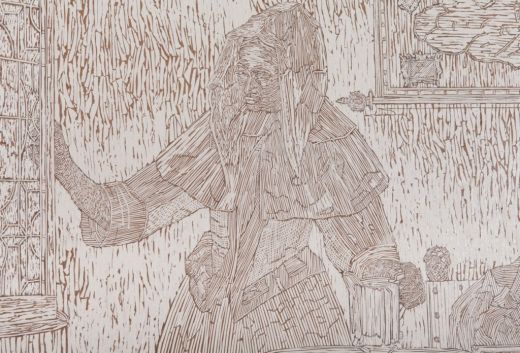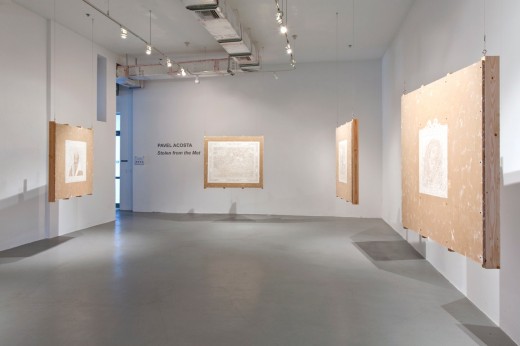Pavel Acosta, Stolen From the Met
Hunter Braithwaite

Detail of Pavel Acosta's "Young Woman With a Water Pitcher by Johannes Vermeer. Dry Paint on Sheetrock. 48x48"
March 8-April 25, 2014
Old master paintings are a black hole in the middle of our current discussion of painting. They confound the market by being priceless. They frustrate questions of the relationship between image and surface by satisfying both, in their own way. An old master painting is both pure image, in how it’s been ingested into the collective visual memory, and pure object, in how it’s either seen as a souvenir (Mona Lisa mouse pad, anyone?) or, when encountered up close and personal, always seems darker, heavier, clunkier than you’d expect.
In a small front gallery with exposed ductwork, Pavel Acosta (b. 1980, Cuba) presents a meticulous and nimble series of six old masters displayed on drywall. The drywall is itself mounted on four 2×4 studs and suspended from the ceiling by wire. Acosta paints the sheets white, then peels the paint of off, and then, with the dexterity of a conservator (or a counterfeiter) assembles the paint chips to recreate icons of Western art history, frame and all.

” the banal violence of lumping so many disparate painted into the non-genre of masterpiece”
Acosta considers how iconic paintings can remain physical objects once they enter the collective image dump. The deliberate scattering of paint chips mimics the craquelure of aging masterpieces. The missing color suggests vision sans aesthetic pleasure. I often fantasize about all of the different imaging systems used by conservators or appraisers: carbon dating, x-ray technology—robot eyes, responding to physical condition, not painterly magic. How does a heat-seeking missile see a Rubens?
All are recreated with a scale of 1:1, with Van Gogh’s “Wheat Field with Cypresses” being the largest. Since each composition is different size, and since each is displayed on an identical square of drywall (four ft2) all float in a shifting and scuffed brown puddle of drywall. This generic setting asks us to consider the banal violence of lumping so many disparate painted into the non-genre of masterpiece.
But consider the black hole. It’s nearly impossible to update an old master without getting sucked past that event horizon of gimmick. Mona Lisa on toast, Odilon Redon’s Cyclops tattooed around someone’s bellybutton. (Don’t know if that one exists, yet.) Somehow, Acosta holds his own. His collage of paint chips doesn’t just match the painter’s brush strokes, but the painter’s world as well. The humble tranquility of the wall in Vermeer’s “Young Woman with a Water Pitcher” is completed with relatively broad sections of white chips, as if the paint belonged to Vermeer’s wall itself. Similarly, the paint radiates from the head of El Greco’s “Portrait of a Man,” suggesting self-appointed divinity, and the schisms of modernity are captured by the manic jags of Picasso’s “Dora Maar in an Armchair.” He’s not just repainting these works, but painting them again. They remain, as paint. Frank O’Hara said that “the portrait show seems to have no faces in it at all, just paint / you suddenly wonder why in the world anyone ever did them.” Perhaps paint isn’t such a bad place to start.










